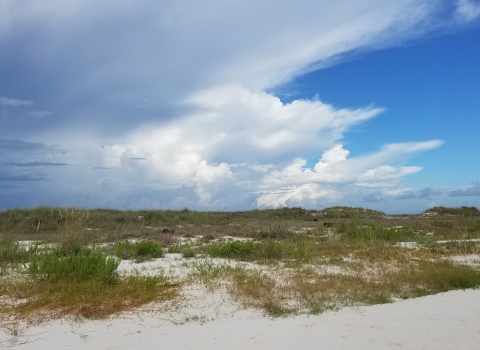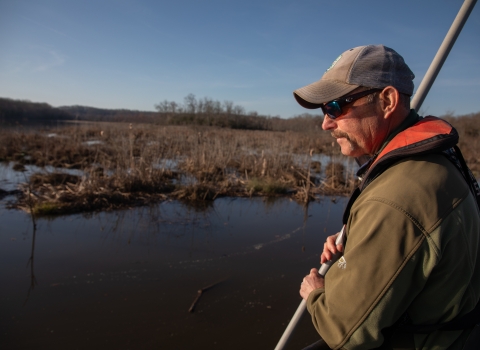What is the relict darter?
The relict darter is a small fish that occupies a portion of the Bayou de Chien stream system in western Kentucky. It can be distinguished from other darters by the number of fin rays or spines along the top of its back, the color and shape of the top fins of breeding males, and its breeding behavior, which involves egg-clustering with parental care.
Where does the relict darter occur?
The relict darter occurs in two geographically isolated populations occupying approximately 33 stream miles in Bayou de Chien/Jackson Creek and Little Bayou de Chien. It typically lives in slow-flowing runs, glides, or pools of small to medium-sized, lowland streams with sand and gravel substrates. In these habitats, it is typically observed near cover, such as undercut banks, woody debris piles, or snags. Relict darters feed primarily on midge larvae and other small invertebrates. Spawning occurs from mid-March to early June, and the fish has a maximum lifespan of three to four years.
What action is the U.S. Fish and Wildlife Service proposing?
The Service is proposing to reclassify the relict darter from endangered to threatened under the Endangered Species Act (ESA) and to develop a proposed rule under section 4(d) that tailors protections for the relict darter. We are also announcing the availability of a draft recovery plan for the species, which includes specific recovery objectives and revised recovery criteria. The Service is seeking comments on these proposed actions and accompanying documents.
Why is the Service proposing a reclassification of the relict darter?
The proposed reclassification is based on the Service’s evaluation of the best available scientific and commercial information, which indicates that the species’ status has improved to the point that it is not currently in danger of extinction. While the relict darter is on the road to recovery, it is still at risk of extinction in the foreseeable future, thus meeting the definition of a threatened species under the ESA.
What are the threats to the relict darter?
Habitat loss and degradation and reduced range/isolation are the principal threats to the relict darter. These threats are due to siltation (excess sediments suspended or deposited in a stream), channelization/riparian vegetation removal, drainage of riparian riparian
Definition of riparian habitat or riparian areas.
Learn more about riparian wetlands, and water quality degradation (pollution). Future threats from climate change climate change
Climate change includes both global warming driven by human-induced emissions of greenhouse gases and the resulting large-scale shifts in weather patterns. Though there have been previous periods of climatic change, since the mid-20th century humans have had an unprecedented impact on Earth's climate system and caused change on a global scale.
Learn more about climate change that will likely impact the species include an increase in average annual temperatures and drought occurrences in relict darter habitat.
What conservation efforts have helped improve the relict darter’s status?
The relict darter was first listed as an endangered species in 1993 due to pollution, siltation and habitat deterioration, associated with steam channelization and poor land use practices. Since then, the species’ status has improved through the implementation of conservation actions in the Bayou de Chien stream system. The Service has worked with multiple agencies and private partners, including the Natural Resources Conservation Service, Kentucky Department of Fish and Wildlife Resources, and The Nature Conservancy. The Service’s Partners for Fish and Wildlife (PFW) Program has taken a lead role in this effort by providing technical and financial assistance to agencies and numerous private landowners.
PFW biologists have focused their efforts on the use of best management practices (BMPs) and instream conservation practices that enhance and restore riparian habitats and the instream habitats used by the relict darter. PFW projects have included a culvert removal in the headwaters of Bayou de Chien, installation of livestock alternate watering systems, placement of artificial spawning structures in Bayou de Chien and Jackson Creek, installation of livestock exclusion fencing along several miles of Bayou de Chien and Jackson Creek, and restoration of over 50 acres of native grasses and wildflowers within riparian areas. In addition to these efforts, PFW biologists have provided over 10 years of technical assistance to the U.S. Department of Agriculture (USDA), Wetland Reserve Easement Program, for projects within the Bayou de Chien system. These efforts have resulted in conservation easements covering over 1,700 acres in the upper Bayou de Chien stream system. USDA’s Conservation Reserve Program has also been responsible for the installation of soil stability structures and grassed waterways over hundreds of acres in the Bayou de Chien watershed, helping to keep sediment from agricultural practices out of streams.
What is a 4(d) rule?
For a threatened species, the Service may use the flexibility provided under the ESA’s Section 4(d) to tailor take prohibitions to those that provide conservation benefits for the species – referred to as a 4(d) rule. This targeted approach can reduce ESA conflicts by allowing some activities to continue that may benefit and not significantly harm the darter, while focusing efforts on the threats that slow the species’ recovery. These customized protections minimize the regulatory burden while maximizing the likelihood of recovery for threatened species.
Under the proposed 4(d) rule, prohibitions that typically apply to endangered wildlife will also apply to relict darter. The Service’s proposed 4(d) rule provides exceptions to incidental take provisions to accommodate permitted activities. These include state cooperative agreement conservation programs, law enforcement actions, and incidental take associated with channel reconfiguration or restoration projects, bank stabilization projects, bridge and culvert replacements and low head dam removals. It would also cover transportation projects that provide fish passage fish passage
Fish passage is the ability of fish or other aquatic species to move freely throughout their life to find food, reproduce, and complete their natural migration cycles. Millions of barriers to fish passage across the country are fragmenting habitat and leading to species declines. The U.S. Fish and Wildlife Service's National Fish Passage Program is working to reconnect watersheds to benefit both wildlife and people.
Learn more about fish passage if conducted outside the relict darter breeding season (March 1 – June 30) following best management practices. The proposed 4(d) rule also would exempt Natural Resource Conservation Service projects that benefit relict darter, although interagency consultation under section 7 of the ESA may still be required.
How do I submit comments on this proposal?
The Service will accept comments received or postmarked on or before May 2, 2022. Comments submitted electronically using the Federal eRulemaking Portal (see ADDRESSES, below) must be received by 11:59 p.m. Eastern Time on the closing date. We must receive requests for public hearings, in writing, at the address shown in FOR FURTHER INFORMATION CONTACT by April 18, 2022.
ADDRESSES: You may submit comments by one of the following methods:
(1) Electronically: Go to the Federal eRulemaking Portal: http://www.regulations.gov. In the Search box, enter Docket No. FWS–R4–ES–2021–0093, which is the docket number for this rulemaking. Then, click on the Search button. On the resulting page, in the Search panel on the left side of the screen, under the Document Type heading, check the Proposed Rule box to locate this document. You may submit a comment by clicking on “Comment Now!”
(2) By hard copy: Submit by U.S. mail to: Public Comments Processing, Attn: Docket No. FWS–R4–ES–2021–0093, U.S. Fish and Wildlife Service, MS: BPHC, 5275 Leesburg Pike, Falls Church, VA 22041–3803.
We request that you send comments only by the methods described above. We will post all comments on http://www.regulations.gov. This generally means that we will post any personal information you provide us.
Document availability: This proposed rule and supporting documents, including the 5-year review, the draft Recovery Plan, and the species status assessment (SSA) report are available at http://www.regulations.gov under Docket No. FWS–R4–ES–2021–0093, and at the Kentucky Ecological Services Field Office (see FOR FURTHER INFORMATION CONTACT).
For Further Information Contact: Lee Andrews, Field Supervisor, U.S. Fish and Wildlife Service, Kentucky Ecological Services Field Office, 330 West Broadway, Suite 265, Frankfort, KY, 40601. Persons who use a telecommunications device for the deaf (TDD) may call the Federal Relay Service at 800–877–8339.
What information is the Service requesting?
The Service intends that any final action resulting from this proposed rule will be based on the best scientific and commercial data available and be as accurate and as effective as possible. Therefore, we are requesting comments or information from other concerned governmental agencies, Native American tribes, the scientific community, industry, or any other interested parties.
The Service is particularly seeking comments concerning:
(1) The species’ biology, range, and population trends;
(2) Factors that may affect the continued existence of the species;
(3) Biological, commercial trade, or other relevant data concerning any threats;
(4) Additional information concerning the historical and current status, range, distribution, and population size of this species, including the locations of any additional populations of this species; and
(5) Information on regulations that are necessary and advisable to provide for the conservation of the relict darter that the Service can consider in developing a 4(d) rule for the species.
Submissions merely stating support for or opposition to the proposed rule, while noted, will not be considered in making a determination.
Press release
Read the press release that accompanies these frequently asked questions.




